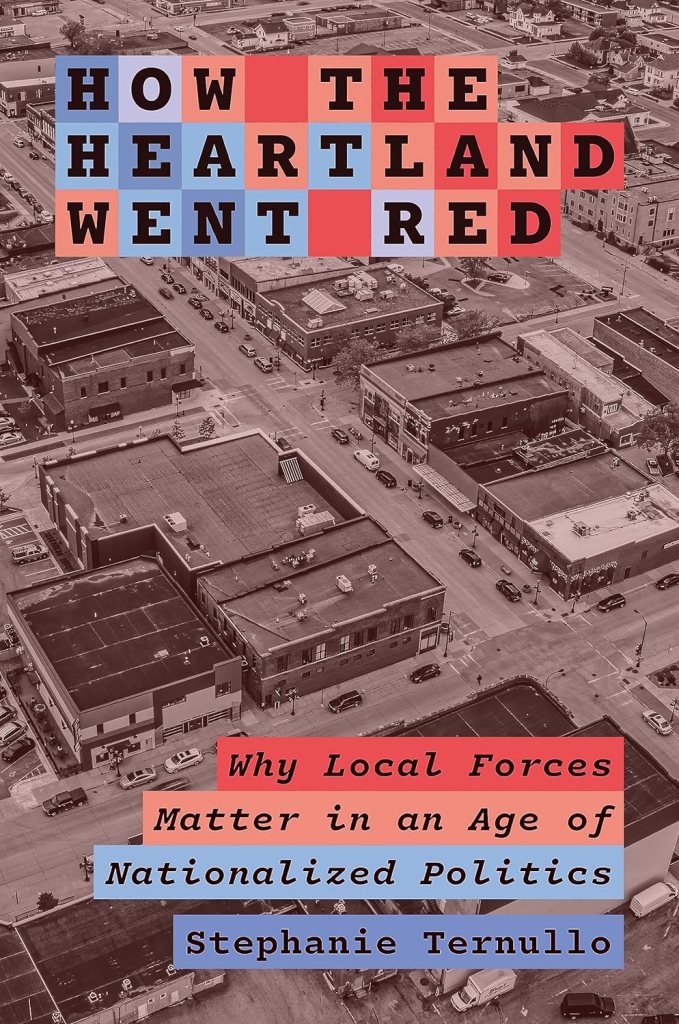White, working-class voters have been defecting from the Democratic Party for more than six decades in the nation’s heartland.

In her new book “How the Heartland Went Red,” Stephanie Ternullo tracks the evolution of three predominantly white cities in the post-industrial Midwest to understand the shift. The assistant professor of government detailed her findings at a campus talk last week
“I wanted places that at once shared the same demographics, and still do, but took different political trajectories,” she said of her project, which helps illuminate the roles of race, class, and religion in the change. One city remains solidly blue. A second has been dominated by Republicans since the 1960s, and a third was split until Donald Trump won them over with his 2016 candidacy.
Ternullo’s work follows decades of what the political scientist calls an “explosion” of scholarship on the relationship between social identity and partisanship. “The classic account,” she explained at the event hosted by Harvard’s Center for Race, Inequality and Social Equity Studies, “is that voting is essentially a group experience.”
The Great Depression and World War II represented the height of class politics, Ternullo said. Between 1932 and 1944, a total of 467 predominantly white, working-class U.S. counties lined up behind President Franklin Delano Roosevelt, according to her analysis. Voters in these municipalities favored the New Deal Democrat four elections in a row.
Then came re-orderings along racial, religious, and socioeconomic lines. “About two-thirds of the counties turned right after the racial realignment of the 1960s,” Ternullo said, gesturing to transformations set in motion by the civil rights movement. “Another 11 percent turned to the right with consolidation of the religious right in the early 2000s.”
Along the way came deindustrialization and the decline of organized labor, a cornerstone of the New Deal coalition. The transformation was all but complete with the arrival of the Tea Party and former President Donald Trump, both documented by social scientists as capitalizing on status threats felt by white, working-class voters. By 2016, 96 percent of the original “New Deal” counties were solidly on the right.
Ternullo’s book returns to this important subset of Roosevelt’s historic voting bloc. She conducted more than a year of intensive field work in a trio of Upper Midwestern cities. All three, pseudonymized in the book, have overwhelmingly white populations numbering between 16,000 and 28,000 people today. All three boasted strong industrial economics at mid-20th century. Today, each is aging faster than the larger U.S. population.
Ternullo’s book returns to this important subset of Roosevelt’s historic voting bloc. She conducted more than a year of intensive field work in a trio of Upper Midwestern cities.
The book’s outlier is a city Ternullo calls Motorville, Wisconsin. It retains many of the same unionized, private manufacturing employers that operated in the 1950s. Residents are, however, scarred after decades of mergers and layoffs. What really sets it apart, Ternullo argued, is the fact that it retains a local labor council, or a community-specific unit of the AFL-CIO.
“This is exceedingly rare in the 21st century,” she noted. “If you go to a labor council meeting, you’ll see the postal workers there. People representing supermarket clerks are there. The IBEW is there. And they’re talking about issues relevant to local politics and community life.”
Lutherton, Indiana, is the Republican stronghold in Ternullo’s book. Residents there carry the generational memory of losing the city’s largest employer in the 1970s. Anchoring its economy today is a unionized auto parts manufacturer that was later lured by the local economic council. Of the three case studies, Lutherton is the only one to gain population since 1980.
Union membership in the city remains strong, though organized labor lacks a politically mobilized presence. “But the city does have a set of well-resourced churches and nonprofits that coordinate a private problem-solving network that jumps into action anytime new social problems emerge,” Ternullo said.
The largest employer in Gravesend, Minnesota, burned down in the 1990s and opted against rebuilding. Of the three cities, Gravesend has the lowest percentage of unionized workers today. It also counts the highest share of service sector jobs.
At one point, Gravesend enjoyed the active presence of unions and churches. They were never as robust as those in Motorville and Lutherton, and they ended up declining with the town’s manufacturing sector. “That leaves people feeling like their community is dying, and they have no coherent leadership telling them how to resolve it,” Ternullo offered.
“My argument is that people make sense of local economic conditions and national politics from within these organizational contexts.”
The book digs into the economic and political histories of all three communities, completed with the help of archival research, social media analysis, and interviews with community leaders. But the recent talk focused largely on the role unions and churches can play in an era of nationalized politics.
“My argument is that people make sense of local economic conditions and national politics from within these organizational contexts,” said Ternullo, who emphasized that the effects extend even to neighbors without direct group membership.
Motorville is in this way a bit of an anachronism, with residents viewing the Democrats as strongly representative of working-class interests. Voters in Gravesend, on the other hand, described a sense of betrayal by the party they supported not long ago. As one 60-something Gravesender put it: “… the Democratic Party has gotten for more of a giveaway thing. You know, by letting all these illegals in and all this kind of stuff.”
Local forces are especially powerful for what Ternullo called “cross-pressured voters,” or those whose loyalties to different social groups are contested with every election. In recent decades, she noted, they include not just working-class white voters but also U.S. citizens of Asian and Latin American descent.
“Place can help make certain social identities more salient than others,” Ternullo said. “It can help prioritize certain interpretations of politics over others, and ultimately lead people to find a home in one party.”
Source link

